In a front page letter dated July 27, 1887 and addressed to the Man-on-the-Band-Stand from the Pine Ridge Agency, Marianna Burgess, who was recruiting new students to the Carlisle Indian School, complained of her uncomfortable accommodations and surroundings. The second page featured "A Story of the Peach Tree" analogous to the planting of…
Indian Helper, The (1885-1900)
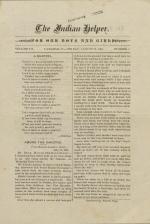
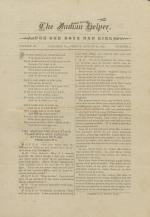
The first page featured a conversation, continued from the previous week’s issue, between Marianna Burgess and the Man-on-the-Band-Stand, related to the filthiness of the Indians at the Pine Ridge and Rosebud Agencies. Topics included a description of issue day and harvesting cattle. Page two reported Miss Fisher's (Acting Principal) train trip…
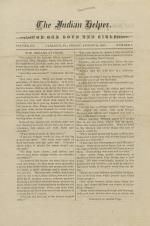
The first page continued Marianna Burgess' report of conditions at the Rosebud and Pine Ridge Sioux Agencies begun in Volume 2, including her visit to Luther Standing Bear's home. Page two reported a visit to the school by some deaf school principals who "much interested our boys with their silent ways of talking," likening manualism to Indian…
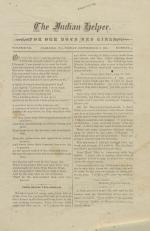
The first page opened with a temperance poem and a reprint of a letter received from Minnie Yellowbear, who returned to Indian Territory and was teaching at the Arapaho school. Page two reported the practice of government and missionary teachers using native language curricula along with English language curricula, and urged Carlisle students…
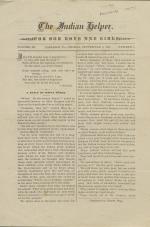
The first page opened with a short poem followed by a conversation continued from previous weeks between Marianna Burgess and the Man-on-the-band-stand describing her recruitment trip among the Rosebud and Pine Ridge Sioux. Page two reported contents of letters from student Josephine Bordeaux (Sioux), who had returned home and Jennie…
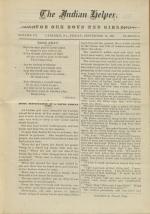
The first page opened with the poem, "Bang Away," followed by the story of a Carlisle girl who was horrified to return home to unsanitary conditions, continued on page four. This appears to be the beginning segment of a serialized story of a girl who returned home to the challenges of putting her new-found skills learned at Carlisle, in…
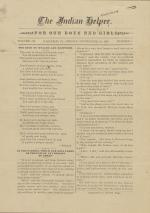
Much of this issue of the newspaper was focused on the Outing Program, since many students were returning to the school from their country homes. The first page opened with the poem, "The Road to Wealth and Happiness," followed by an article entitled, "Is the Farming Which Our Boys Learn In the East of any Benefit to Them?," which compared East…
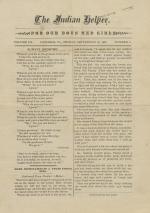
The first page opened with the poem, "Always Growing," followed by a continuation of the "Home Difficulties of a Young Girl" first offered in the Volume 3, Number 6 issue. In this episode, "Fanny" the returned Carlisle protagonist set out to put things right, finally recovering from her despair at first finding her childhood home in such a mess…
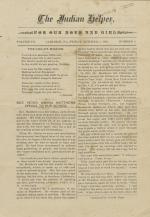
Page one opened with the poem, "The Child's Mission," followed by a report called "Rev. Peter Owaha Matthews Speaks to Our School," which was continued on the fourth page. It was the account of an assimilated Indian and the trials he overcame to become a successful, educated professional. Page two contained news of the literary and…
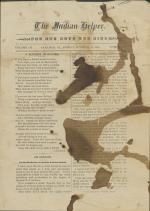
The first page began with the poem, "Sermon in Rhyme," followed by Carlos Montezuma's "An Apache" in which he wrote from the Chicago Medical College telling his story of being kidnapped and raised in the white world. His account continued on page four. Page two included the account of the death of student Bruce Hayman (Pawnee) who died visiting…
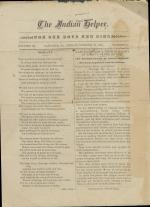
The first page began with the poem, "Nobility," by Alice Cary followed by "A Letter from a Dear Old Lady of Eighty Years of Age," who shared her childhood recollections of life among the Tuscarora Indians camped on her family's land in Canada, some of whom became her playmates. This letter was continued on the fourth page. The second page…
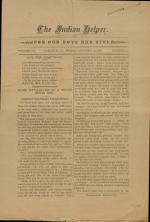
This issue began with the poem, "Live for Something," followed by the continuation of the series begun in Number 8 entitled "Home Difficulties of a Young Indian Girl," about Fanny, a Carlisle alumnus struggling to apply her new-found skills to home life. The second page featured news items including a report from the Hampton School in…
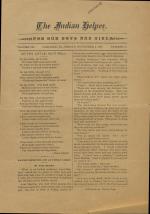
The first page opened with the poem, "Do Thy Little; Do it Well," followed by a story by Aunt Martha called "Pawnee Medicine and an Indian Lodge," about Pawnee dances and medicine men. The second page featured news about the steam printer, the return of Miss Ely, an open air concert by the band, the Indian Union Debating Club, and a…
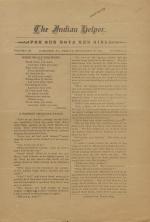
The first page featured a poem "Work While You Work" followed by "A Pawnee Medicine-Dance" which continued the story from number 14 told by Aunt Martha about Pawnee medicine men and their dances. The second page had news of returned students whose terms at Carlisle were completed, including Minnie Swallow Bear, Annie Menaul, and Thomas Rester.…
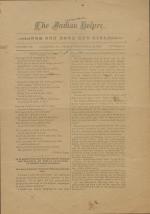
The first page opened with the poem, "Work and Play," followed by a reprint of Dennison Wheelock's first prize essay entitled, "Is It Right for the Government to Stop the Teaching of Indian Languages in Reservation Schools," arguing for the affirmative. The second page featured news about students who returned home after completing their terms…
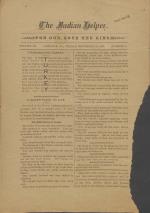
The first page opened with a poem, "Thanksgiving Turkey," a play on the letters in the word "Turkey" followed by a description of the Acoma Pueblo by student Annie Thomas, entitled "A Queer Place To Live." This also was a subject of the article written about the monthly exhibition on page 3. The second page included news of students who…
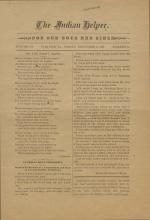
The first page opened with a poem, "Do the Right, Boys," followed by a letter from Richard Yellow Robe, entitled "An Indian Boy's Experience: Written by Himself as a Composition and Read at our last Month's Exhibition" about his escape from the battle in which Custer was killed and his subsequent enrollment in the Carlisle Indian School.…
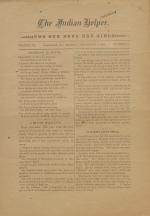
The first page opened with a short poem, "Grammar In Rhyme," followed by the memoir of Sioux student, Hope Red Bear about the Battle of the Big Horn, entitled "A Bit of Wild Life." There was also a piece about the treatment of horses called "If Horses Could Speak." The second page featured news of the passing of former student Dan Tucker'…
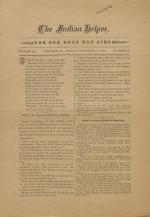
The first page opened with an untitled poem about kindness, followed by "Part of Our Hospital Work," a reprint of a composition by Nancy Cornelius (Oneida) who detailed her experiences as a hospital assistant. She wrote about the breakfast routine and the Apache mothers caring for their babies at the hospital. There was also an article…
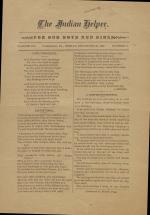
The first page opened with a two poems, "Christmas Eve," and "Christmas," about the true meaning of Christmas. Next came a story about a monkey who developed an intolerance to whiskey, entitled "A Temperance Monkey," which was continued on the fourth page. Page two opened with a report about the monthly exhibition followed by news that the boys…
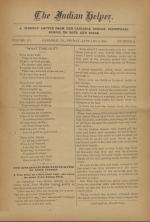
The first page opened with a poem, "What Time Is It?" followed by the story of Indian women whose harvested cache of vegetables had been stolen. The story was titled, "How Some Indians Were Made to Suffer by Their Enemies: A True Story by a Dear, Kind Lady Who Lived For Many Years Among Them." It was signed by A-TE-KA, aka "Aunt Martha," as…
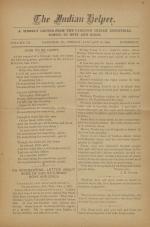
The first page opened with a poem, "How To Be Happy" followed by a reprint of a letter to the school from J. H. Seger of the Cheyenne and Arapahoe Agency dated Jan 4, 1888 that mentioned several students who returned to the Agency. Page two gave a humorous offering by Nellie Carey (Apache) from "her new place in the country," advice for the…
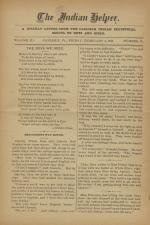
The first page opened with a poem, "Big Fraid and Little Fraid" followed by an article, "Another Pleasant Evening in the Chapel," that detailed the entertainment featuring numerous students reciting or singing poems, songs and reports. It continued on page four, which is missing from the collection. Page two included a reference to the borough'…
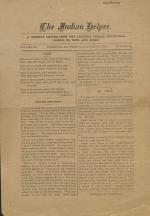
The first page opened with a poem, "Dare," followed by a story, "Engines and Boys," that reported the arrival by train of the new fire engine called "Uncle Sam." Then came a piece entitled, "Be Neat," on the importance of being neat and orderly. It continued on page four. Page two reported the experience of the four girls who visited the White…
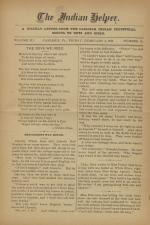
The first page opened with a poem, "The Boys We Need," reprinted from "Golden Days;" followed by a fictitious fable of two Carlisle students, "The Longest Way Round," warning against taking shortcuts. The page also included two blurbs about the blizzard in the West. Page two opened with a feature "What the Man-on-the-band-stand Heard Some…
